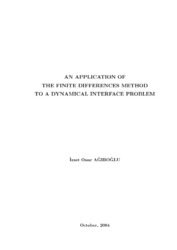Please use this identifier to cite or link to this item:
https://hdl.handle.net/11147/3325Full metadata record
| DC Field | Value | Language |
|---|---|---|
| dc.contributor.advisor | Tanoğlu, Gamze | en |
| dc.contributor.author | Ağıroğlu, İzzet Onur | - |
| dc.date.accessioned | 2014-07-22T13:51:20Z | - |
| dc.date.available | 2014-07-22T13:51:20Z | - |
| dc.date.issued | 2004 | en |
| dc.identifier.uri | http://hdl.handle.net/11147/3325 | - |
| dc.description | Thesis (Master)--Izmir Institute of Technology, Mathematics, Izmir, 2004 | en |
| dc.description | Includes bibliographical references (leaves: 41-43) | en |
| dc.description | Text in English; Abstract: Turkish and English | en |
| dc.description | viii, 49 leaves | en |
| dc.description.abstract | A multiple-order-parameter model for Cu-Au system on a face cubic centered lattice was recently developed in the presence of anisotropy. In that model, three order parameters (non-conserved) and one concentration order parameter (conserved), which has been taken as a constant, were considered. Later on, the model has been extended, so that, concentration has been taken as a variable. It has been seen that two models were in a good agreement near critical temperature since the non-conserved order parameter behaves like a constant near critical temperature in both models. Thus, we extended the rst model to a dynamical diffuse interface model near critical temperature. After writing the free energy of the system in terms of the order parameters, minimizing the energy with respect to the order parameters and Langevin equation yield the non-linear system of parabolic equations. The finite differences method was implemented to solve this non-linear system of parabolic equations. The forward difference discretization was applied for the rst derivative of the solution with respect to time and centered difference discretization was applied for the second order derivative of the solution with respect to spatial variable. We obtained stability criteria and nd the error bound. The orientation dependence proles, variation of interfacial energy and the effect of the degree of the anisotropy on the width of the diffuse interface are simulated when the time evolves. | en |
| dc.language.iso | en | en_US |
| dc.publisher | Izmir Institute of Technology | en |
| dc.rights | info:eu-repo/semantics/openAccess | en_US |
| dc.subject.lcc | QA431 .A26 2004 | en |
| dc.subject.lcsh | Finite differences | en |
| dc.title | An application of the finite differences method to a dynamical interface problem | en_US |
| dc.type | Master Thesis | en_US |
| dc.institutionauthor | Ağıroğlu, İzzet Onur | - |
| dc.department | Thesis (Master)--İzmir Institute of Technology, Mathematics | en_US |
| dc.relation.publicationcategory | Tez | en_US |
| item.fulltext | With Fulltext | - |
| item.openairecristype | http://purl.org/coar/resource_type/c_18cf | - |
| item.grantfulltext | open | - |
| item.cerifentitytype | Publications | - |
| item.openairetype | Master Thesis | - |
| item.languageiso639-1 | en | - |
| Appears in Collections: | Master Degree / Yüksek Lisans Tezleri | |
Files in This Item:
| File | Description | Size | Format | |
|---|---|---|---|---|
| T000445.pdf | MasterThesis | 3.91 MB | Adobe PDF |  View/Open |
CORE Recommender
Page view(s)
120
checked on May 6, 2024
Download(s)
32
checked on May 6, 2024
Google ScholarTM
Check
Items in GCRIS Repository are protected by copyright, with all rights reserved, unless otherwise indicated.